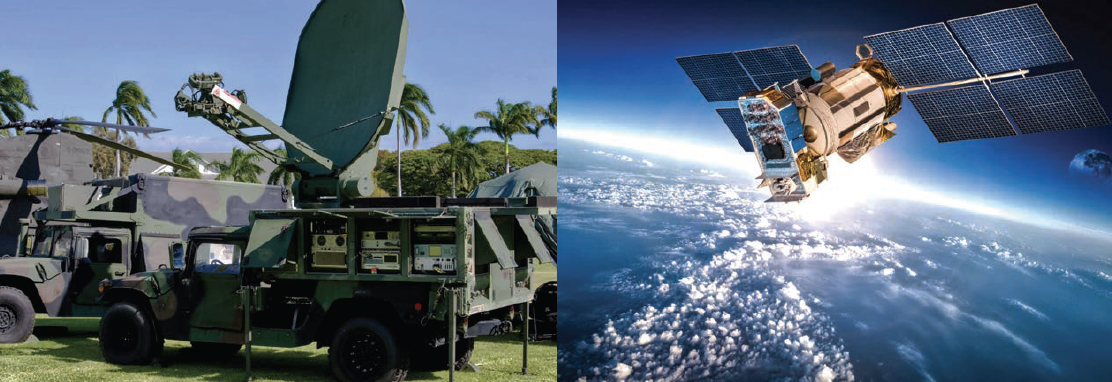Simon Swift, Engineering Director - Digital Technologies at ETL Systems and Chair of the DIFI Specification Working Group
As the threat landscape and the nature of warfare continue to evolve, so, too, does the technology being trialed by global governments.

As part of the Future Soldier program, UK soldiers recently tested the next generation of body-worn technologies, aiming to, “integrate available technology into wearable tech for soldiers, advancing battlefield awareness and allowing faster tactical decision making.”
Other examples of new technologies being trialed included laser and drone thermal detection and ground sensors to detect enemy movement with alerts then sent to body-worn systems.
To effectively process all the additional data flying around the battlefield, a reliable, resilient, flexible—but most importantly secure —connection is needed, with those on the ground and in control centers making mission-critical decisions based on real-time data and information.
The question is, what impact does this have on both tactical and strategic ground stations and networks, and can they deliver what is now required?
Investment is set to increase—bandwidth must follow One paper, published in 2022, emphasised that SATCOM was by far the biggest project within the UK’s Defence Space Strategy.
SKYNET 6, the MOD’s family of military communications satellites designed to provide strategic communication services to the UK Armed Forces, is at its center... “this priority is by no means surprising – increasing bandwidth is critical as part of the integration into other domains, with new intelligence, surveillance, and reconnaissance (ISR) capabilities transmitting large amounts of data being just one example.”
Increasing network capacity in line with growing demand across both government and enterprise markets is clearly a key priority, and something of which the Institute of Electrical and Electronics Engineers’ (IEEE) is acutely aware.
Currently, the highest standardized rate of Ethernet available is 400 Gigabit per second (Gb/s). Positively, the 800G Ethernet standard, developed by the IEEE P802.3df Task Force, was approved in February of 2024, with work on the 1.6 Tbit/s Ethernet also anticipated to be completed by the IEEE’s 802.3dj Task Force in July of 2026—two big steps forward for the industry.
Both of these task forces were formed following the release of the IEEE’s 802.3 2020 Ethernet Bandwidth Assessment, where it was highlighted that bandwidth growth rates in 2025 were expected to have grown by 2.3 to 55.4 times the traffic levels that were experienced in 2017.
Now, we know that bandwidth growth rates did continue to increase, albeit at a slightly slower rate in 2024, owing to the ongoing thirst for consuming data on the move. According to one TeleGeography report, total international bandwidth now stands at 1,479 Tbps, representing a 4 year compound annual growth rate (CAGR) of 25%.
Digitization will also have a big impact
In addition, SATCOM is entering a new era of digitization, both in space and on the ground. Digitizing the RF spectrum will help overcome many of the common hurdles associated with transporting signals through analogue means, ensuring more flexible, reliable and resilient connectivity.
Last year, ETL Systems’ new technology, GENUS DIGITAL 5000, was demonstrated at a major trade event. GENUS DIGITAL converts analog RF signals to IP and then back again on a live, satellite link, meeting Digital IF Interoperability (DIFI) Consortium 1.2 standards.
The company is already working on the development of a ‘DIGITAL 1000’ product line, aiming to bring the benefits of Digital IF to terminal/edge devices, which will also benefit government and defence organizations around the world. While this remains a nascent technology, there are significant benefits to digitization.
Preventing signal degradation
Those looking to deploy RF over fiber solutions will need to offset the problems that come with signal degradation and the inherent limit of the distances RF signals can travel from the antenna via the terrestrial networks. Unlike analog RF signals, no signal conditioning is required for an IP data stream.
Remoting antennas
Whether for intelligence, surveillance and reconnaissance (ISR), or communications purposes, there are many benefits to remoting the antenna away from human operators and classified or sensitive equipment.
Consider monitoring equipment overlooking a valley. A Light Electronic Warfare Team (LEWT) would always prefer to be dug in out of the line of fire, something that this technology is able to facilitate. For a communications link, increasing the distance between any RF emitter, which is vulnerable to direction finding (DF) and kinetic strike, will increase security.
Bringing the benefits of virtualization to the edge Another key benefit of digitization is virtualization. Breaking the modem away from the hardware allows a tactical terminal to operate multiple waveforms using the same hardware. This brings significant advantages in terms of Size, Weight and Power (SwaP). The digitizer, as part of the future edge terminal and being waveform agnostic, allows multiple software modems servicing multiple satellite constellations.
Reducing the ground infrastructure
A key challenge for defense organizations is the infrastructure needed to support communication systems. When personnel are deployed on covert missions, or in remote locations, this challenge is heightened.
Those running RF signals over long distances—over fiber—require amplifiers, resulting in isolation challenges and return loss. By digitizing the signal, the number of antenna feeds is reduced. Instead of having a large/complex cable system exiting an antenna, only an Ethernet link is required.
Limiting interception to ensure information security
As digital signals do not radiate in the same way that analog signals do from coaxial cable, there’s a further security benefit to digitization— the act of intercepting the signal becomes far more difficult.
Interestingly, there’s much debate among the DIFI community about the topic of information security. As security requirements increase, so, too, does the cost, and there’s also the added complexity of every country having different security algorithms, requirements, and mission deployments. Some believe that it’s better to use dedicated network security appliances, with security grading appropriate to the mission in question, rather than embedding the cost of such capabilities into every connected device.
RF architecture won’t become redundant
Whatever decisions are made, I’m certain that this new technology won’t make traditional RF architecture redundant, especially for applications with less onerous security requirements. In some cases, analog RF
will make the most sense—both for governments and commercial organizations—will be keen to maximize their existing investments.
Operators with large investments in analog RF processing equipment certainly won’t be looking at an immediate requirement to switch to a digital environment. The flexibility of Digital IF technology will facilitate a gradual transition from analog equipment to the digital realm, leading to a hybrid approach in which both analog and digital technologies work in cooperation.
Looking ahead
Given the growing need for increased capacity, there’s no doubt that ground stations and networks will continue to advance over the coming years, with government and military organisations likely to be early adopters as they look to combat new threats.
Investing in this area will enable reliable, resilient and secure connectivity, even in the harshest and most challenging locations, helping to keep personnel safe and improve intelligence gathering capabilities.



